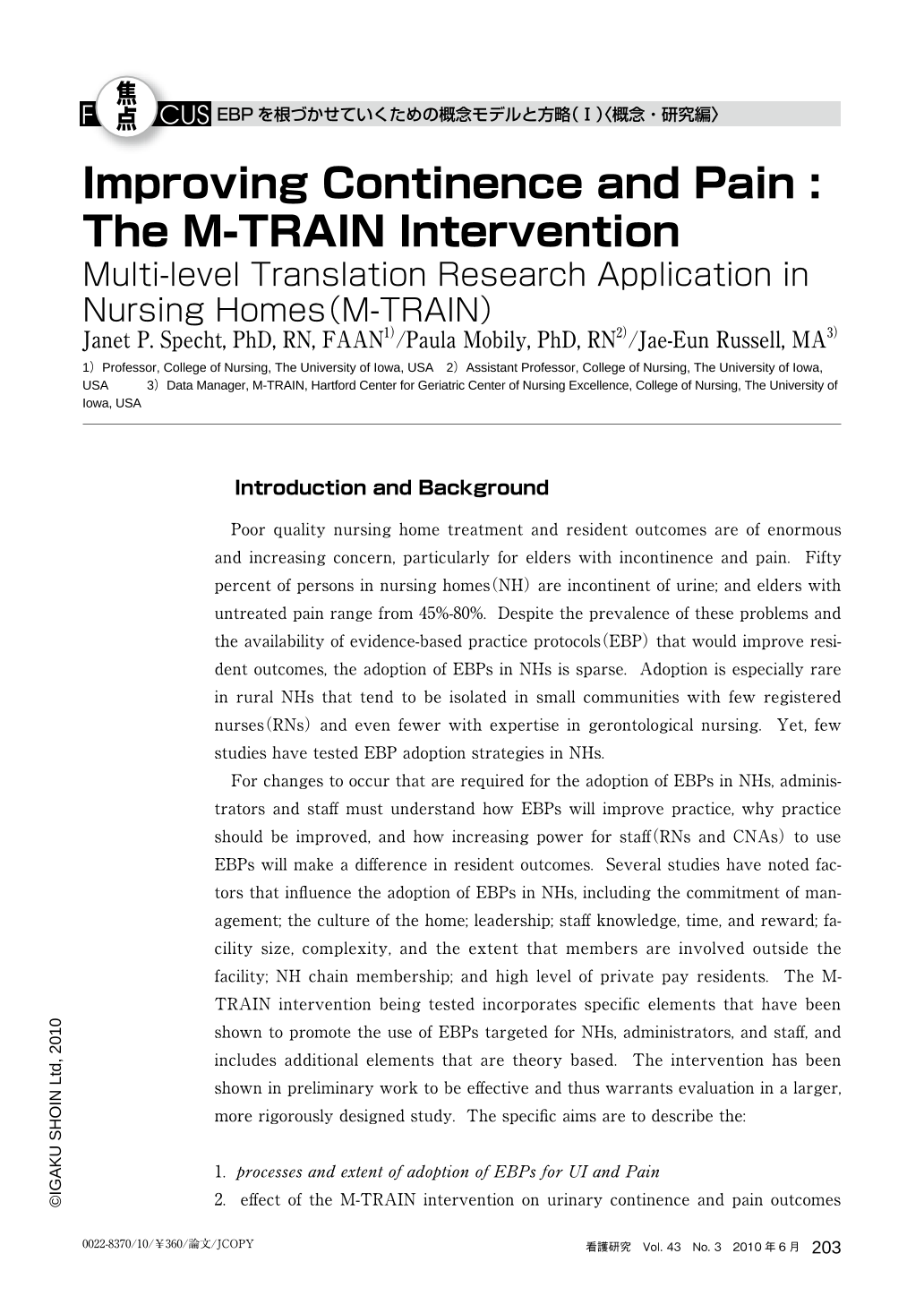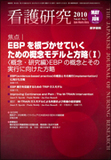Japanese
English
- 有料閲覧
- Abstract 文献概要
- 1ページ目 Look Inside
- 参考文献 Reference
Introduction and Background
Poor quality nursing home treatment and resident outcomes are of enormous and increasing concern, particularly for elders with incontinence and pain. Fifty percent of persons in nursing homes (NH) are incontinent of urine; and elders with untreated pain range from 45%-80%. Despite the prevalence of these problems and the availability of evidence-based practice protocols (EBP) that would improve resident outcomes, the adoption of EBPs in NHs is sparse. Adoption is especially rare in rural NHs that tend to be isolated in small communities with few registered nurses (RNs) and even fewer with expertise in gerontological nursing. Yet, few studies have tested EBP adoption strategies in NHs.
For changes to occur that are required for the adoption of EBPs in NHs, administrators and staff must understand how EBPs will improve practice, why practice should be improved, and how increasing power for staff (RNs and CNAs) to use EBPs will make a difference in resident outcomes. Several studies have noted factors that influence the adoption of EBPs in NHs, including the commitment of management; the culture of the home; leadership; staff knowledge, time, and reward; facility size, complexity, and the extent that members are involved outside the facility; NH chain membership; and high level of private pay residents. The M-TRAIN intervention being tested incorporates specific elements that have been shown to promote the use of EBPs targeted for NHs, administrators, and staff, and includes additional elements that are theory based. The intervention has been shown in preliminary work to be effective and thus warrants evaluation in a larger, more rigorously designed study. The specific aims are to describe the:
1. processes and extent of adoption of EBPs for UI and Pain
2. effect of the M-TRAIN intervention on urinary continence and pain outcomes for elderly NH residents,
3. effect of the M-TRAIN intervention on NH quality outcomes (Quality Indicators, NHQI Quality Measures, state survey violation citations, staff turnover).
4. relationship of facility characteristics with high and low adoption among NHs that receive the intervention
Introduction and Background
Poor quality nursing home treatment and resident outcomes are of enormous and increasing concern, particularly for elders with incontinence and pain. Fifty percent of persons in nursing homes (NH) are incontinent of urine; and elders with untreated pain range from 45%-80%. Despite the prevalence of these problems and the availability of evidence-based practice protocols (EBP) that would improve resident outcomes, the adoption of EBPs in NHs is sparse. Adoption is especially rare in rural NHs that tend to be isolated in small communities with few registered nurses (RNs) and even fewer with expertise in gerontological nursing. Yet, few studies have tested EBP adoption strategies in NHs.
For changes to occur that are required for the adoption of EBPs in NHs, administrators and staff must understand how EBPs will improve practice, why practice should be improved, and how increasing power for staff (RNs and CNAs) to use EBPs will make a difference in resident outcomes. Several studies have noted factors that influence the adoption of EBPs in NHs, including the commitment of management; the culture of the home; leadership; staff knowledge, time, and reward; facility size, complexity, and the extent that members are involved outside the facility; NH chain membership; and high level of private pay residents. The M-TRAIN intervention being tested incorporates specific elements that have been shown to promote the use of EBPs targeted for NHs, administrators, and staff, and includes additional elements that are theory based. The intervention has been shown in preliminary work to be effective and thus warrants evaluation in a larger, more rigorously designed study. The specific aims are to describe the:
1. processes and extent of adoption of EBPs for UI and Pain
2. effect of the M-TRAIN intervention on urinary continence and pain outcomes for elderly NH residents,
3. effect of the M-TRAIN intervention on NH quality outcomes (Quality Indicators, NHQI Quality Measures, state survey violation citations, staff turnover).
4. relationship of facility characteristics with high and low adoption among NHs that receive the intervention

Copyright © 2010, Igaku-Shoin Ltd. All rights reserved.


